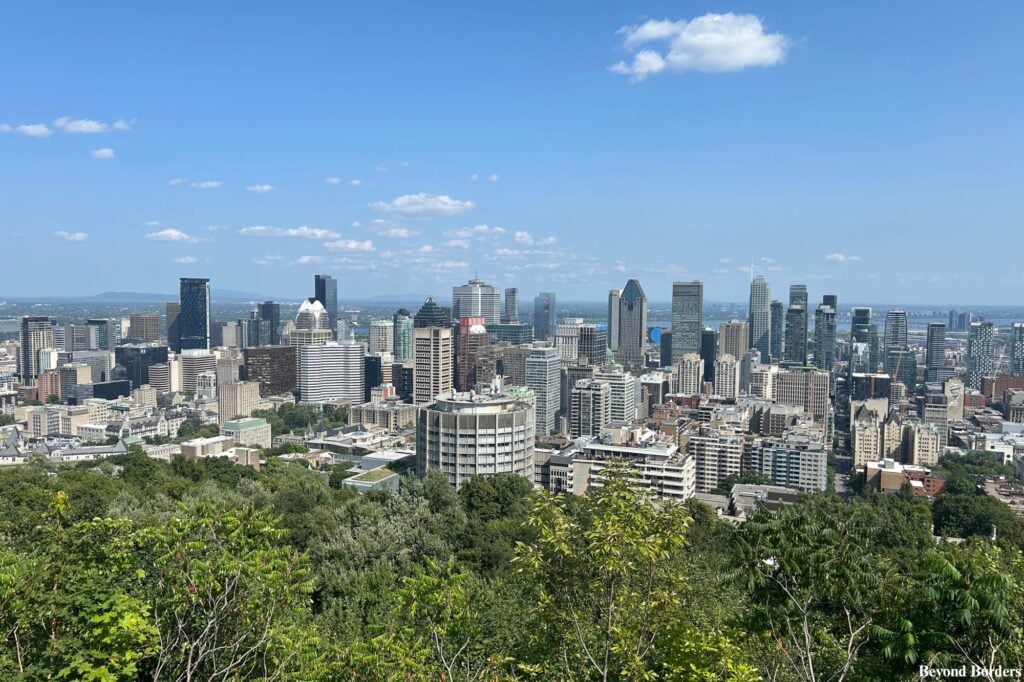Defined by its namesake mountain, Mount Royal, Montreal (Montréal in French) is an island city situated on the Saint Lawrence River in Canada’s Quebec province. With its historic architecture and vibrant, modern downtown, Montreal perfectly illustrates a combination of European charm and North American energy. Montreal has plenty of attractions and landmarks for visitors, including Old Montreal and the Old Port, the Montreal Museum of Fine Arts, and a vibrant and diverse culinary scene to explore! Spending 3 days here is the perfect amount of time to see the city’s highlights without feeling rushed.
Important Notes
This itinerary keeps in mind three full days to explore Montreal. There are no time constraints in this itinerary, allowing you to explore the city at your own pace and keeping in mind potential traffic and the lengths of different tours you might choose. I also offer restaurant recommendations and several alternatives to many attractions.
Using the Montreal métro
Even though the Montreal metro is in French (i.e., all the station names, announcements, and signage are in French, the official language of Quebec), it is very straightforward to use. The subway is operated by the Société de transport de Montréal (STM). On their website, you can see a detailed map of the metro. There are 4 total lines: green, blue, orange, and yellow.
As of summer 2025, visitors cannot use contactless payment (credit/debit card) to use the metro. Instead, visitors can purchase a one-day pass, a three-day pass, or an unlimited weekend pass; read more about visitor passes here. These passes allow for unlimited travel on the metro, buses, and commuter trains within the Montreal Island (also referred to as “Zone A” on the metro website). The 3-day pass works perfectly with this itinerary!
For reference, each subway costs $3.75 CAD ($2.73 USD). Trains run from 5:30am to 1am (1:30am on Saturdays). Read more about the metro on their website here. You can purchase metro passes at the orange kiosks located inside any metro station. You will find them close to the turnstiles, where you tap your pass to get access to the trains.
Day 1
Montreal Museum of Fine Arts (MMFA)
How to get here: Take the metro to the Guy-Concordia station on the green line. Walk onto Blvd. de Maisonneuve Ouest (after leaving the station, you will see a sign that has an arrow pointing in the direction towards the museum) and make a left onto Rue Bishop. Then, make a right onto Rue Sherbrooke (Route 138 East) and the museum will be on the right. You will see a building that says Montreal Museum of Fine Arts (see photo below), but the main entrance is on the other side of the street with the glass doors.
The Montreal Museum of Fine Arts is located in the Golden Square Mile neighborhood, known for its Victorian-era architecture. It is the oldest art museum in Canada, founded in 1860. It is a large and impressive complex that has five pavilions connected by underground tunnels. The entire museum has a vast and diverse collection of nearly 47,000 works. Famous artists whose works are in the museum include pieces by European artists like Rembrandt, Monet, and Rodin. Additionally, the MMFA has a strong collection of Quebec and Canadian art and features one of North America’s finest collections of Indigenous prints, carvings, and other works, which is a major highlight.
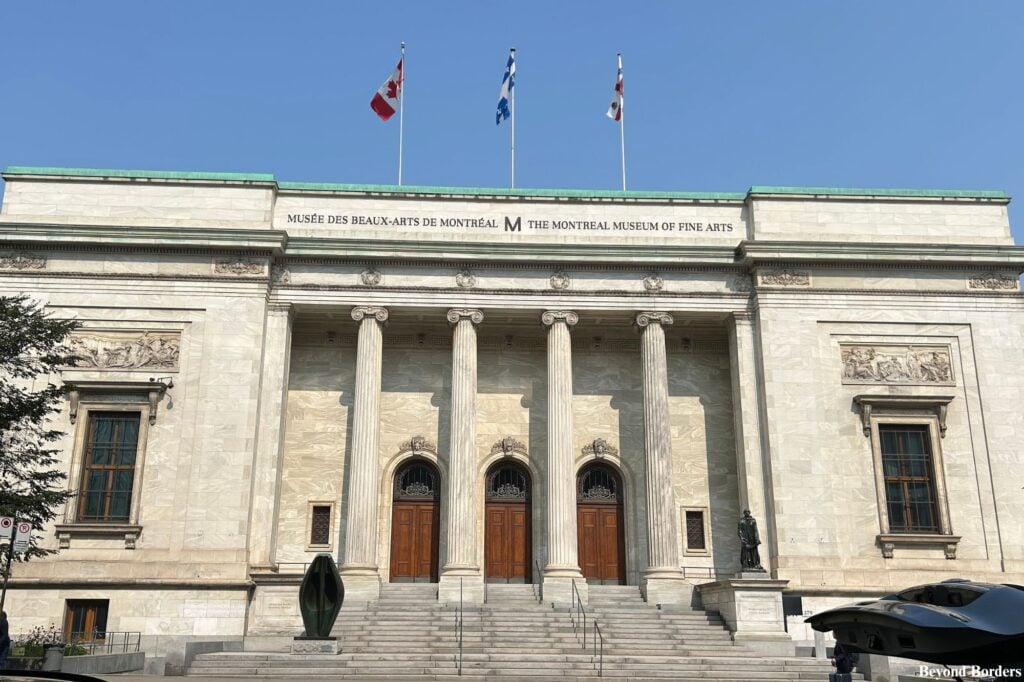

McGill University and Lunch
After leaving the museum, spend some time walking through the Golden Square Mile, getting some lunch, and walking around the McGill University campus if you wish. McGill University is consistently ranked among the top universities in the world and within the top three in Canada (the other two being the University of Toronto and the University of British Columbia). The McGill University address is 845 Rue Sherbrooke West, and you will see campus buildings on Rue University, Rue Peel, Avenue du Docteur-Penfield, and Rue McTavish.
There are hundreds of restaurants and cafés in the Golden Square Mile neighborhood, but some include: Café Myriade (cited as one of the best coffee shops in the city), Columbus Café & Co., Le Warehouse, Joe’s Panini 24h, and Parma Café.


Walking tour of Old Montreal (Vieux-Montréal)
Old Montreal’s cobblestone streets, grand architecture, and rich history make it a must-see for any visitor! The area was founded in 1642 as a French settlement called Ville-Marie, which is actually the name of the borough that contains Old Montreal today.
I highly recommend booking a walking tour of Old Montreal on Viator or GetYourGuide (I booked my tour on Viator). You will see several famous attractions and landmarks on your tour, including the following:
The Old Port was once a busy commercial hub on the St. Lawrence River. Today, the Old Port is a recreational area with a variety of activities, from a large Ferris wheel (La Grande Roue de Montréal) to ziplining and river cruise tours. You will also find walking paths and lots of green space.
The Place d’Armes is a historic and bustling public square in the heart of Old Montreal. It has the Maisonneuve Monument at its center, erected in 1895. It honors Paul de Chomedey, Sieur de Maisonneuve, a founder of Montreal.
The Notre Dame Basilica is said to be the most famous landmark in Old Montreal, located right across from the Place d’Armes. It is a Gothic Revival church, completed in 1829. It is known for its intricate wood carvings, beautiful stained-glass windows, and stunning blue and gold interior. Note: If you want to go inside, you should buy tickets in advance; most tours won’t purchase tickets for you in advance.
Place Jacques Cartier is a public square at the heart of Old Montreal. During the summer, the square is busy, filled with street artists, musicians, cafes, and restaurants with outdoor terraces.
Rue Saint Paul is the city’s oldest street, originally paved in 1672. The street is pedestrian-only and is lined with art galleries, shops, and restaurants, and is popular with tourists and locals alike. It’s a perfect place for a stroll and to get some souvenirs!
Lastly, you will pass the Bonsecours Market, a neoclassical building with its distinctive silver dome close to the Old Port. This building used to be a public market and Montreal’s city hall. Today, it’s a popular spot for shopping, with stores selling locally made handicrafts and Canadian-made products.


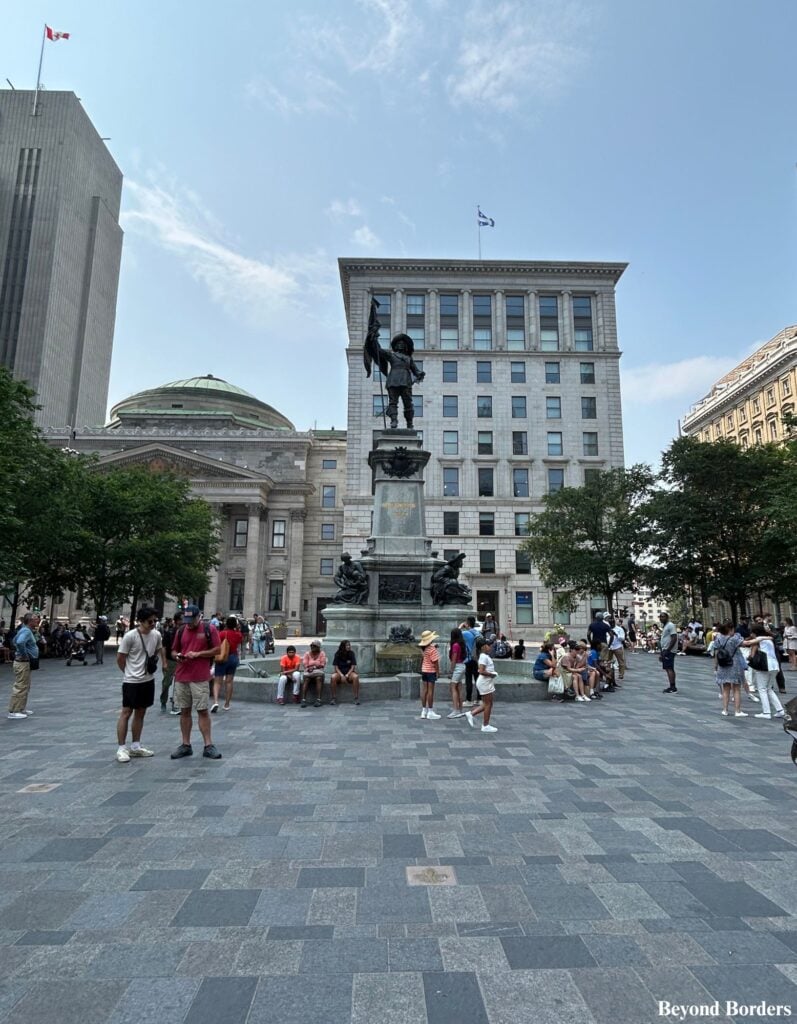
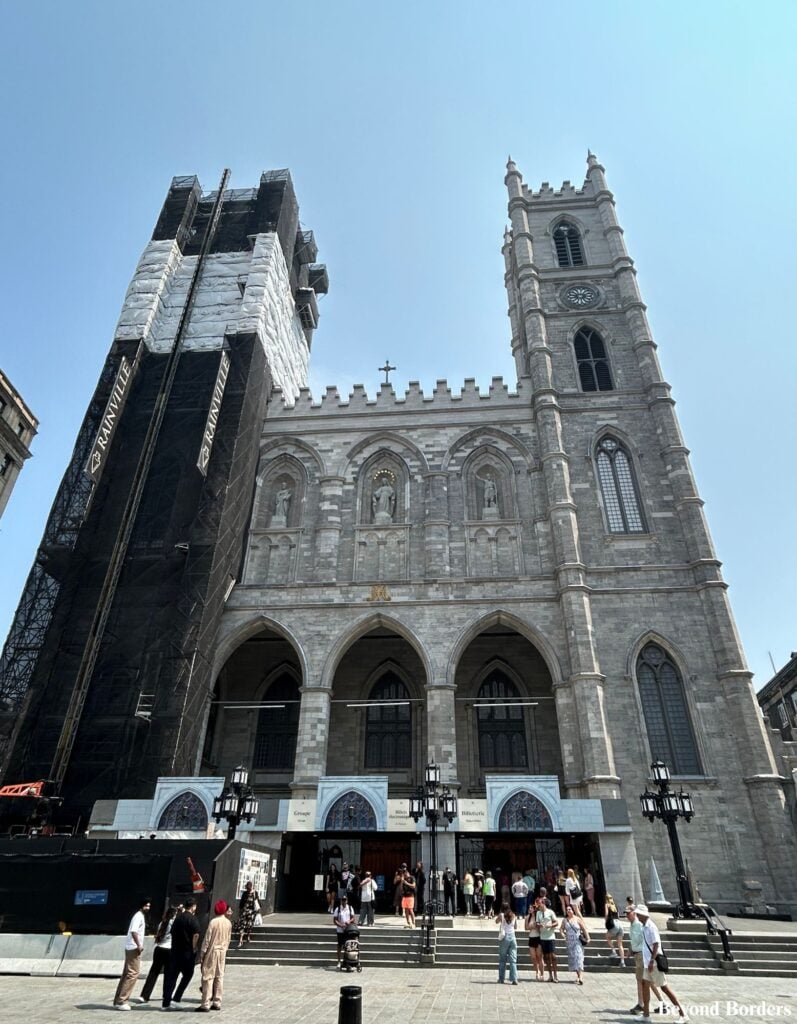

Dinner in Old Montreal
After your walking tour, get dinner in Old Montreal. Popular local restaurants include Modavie, a French restaurant (on the expensive side), Kyo Bar Japonais and Stash Café, a Polish restaurant. I ate a Kyo Bar Japonais and enjoyed it! There are plenty of restaurants to choose from, with options to satisfy every palate and budget, all set against the backdrop of Old Montreal’s historic architecture.
Day 2
Montreal Botanical Garden
How to get here: Take the metro to the Pie-IX station on the green line. When you exit the station, you will walk uphill for about 10 minutes and reach the entrance to the garden. The walk is uphill but not steep. As you walk to the Botanical Garden, you will pass the Montreal Olympic Stadium!
The Montreal Botanical Garden is a National Historic Site of Canada and a renowned, large botanical garden. It was founded in 1931 and is considered one of the most important botanical gardens in the world due to the size and diversity of its collections; the garden is 190 acres and features a collection of over 22,000 plant species and cultivars. The botanical garden houses around 30 thematic gardens; think of it like a bunch of gardens within a large garden. Make sure to visit the Chinese Garden, the Japanese Garden, and the Rose Garden! Other gardens I enjoyed visiting were the toxic plants garden and the alpine garden.
The Botanical Garden also has ten large exhibition greenhouses that are open year-round. They showcase plants from different climates, including tropical rainforests, deserts, and collections of orchids, ferns, and cacti. It also has an extensive arboretum (tree collection) and the Montreal Insectarium, a popular attraction, especially for children, with a collection of living and mounted insects from around the world. You will need to purchase separate tickets to visit the Insectarium.
Be sure to buy tickets online rather than at the entrance so you don’t have to wait in line, especially during the summer months. You can purchase tickets online here.
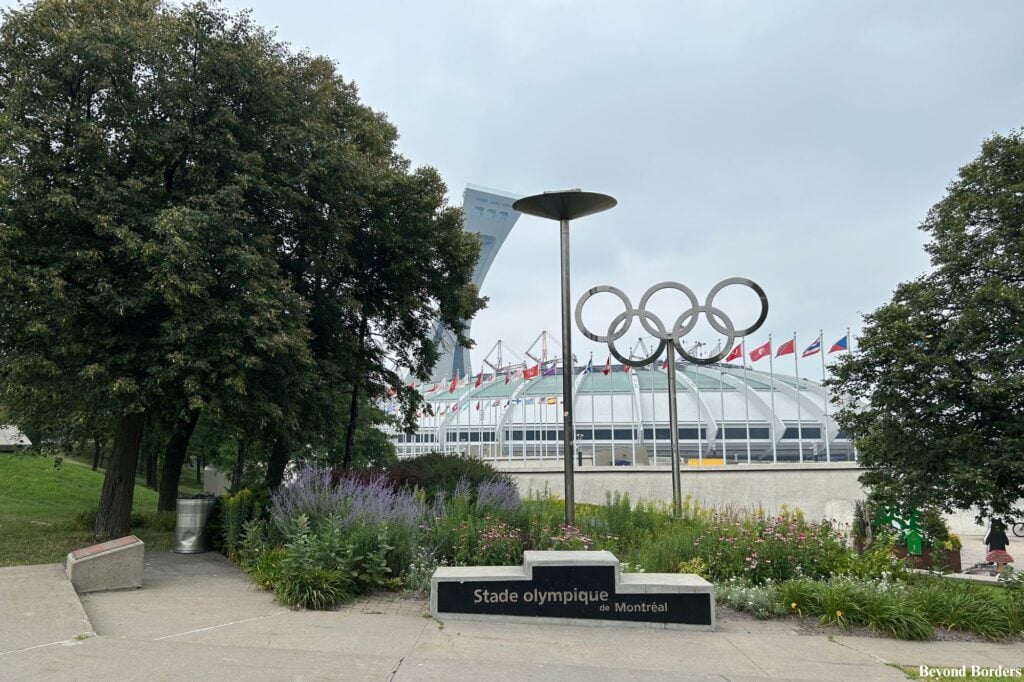

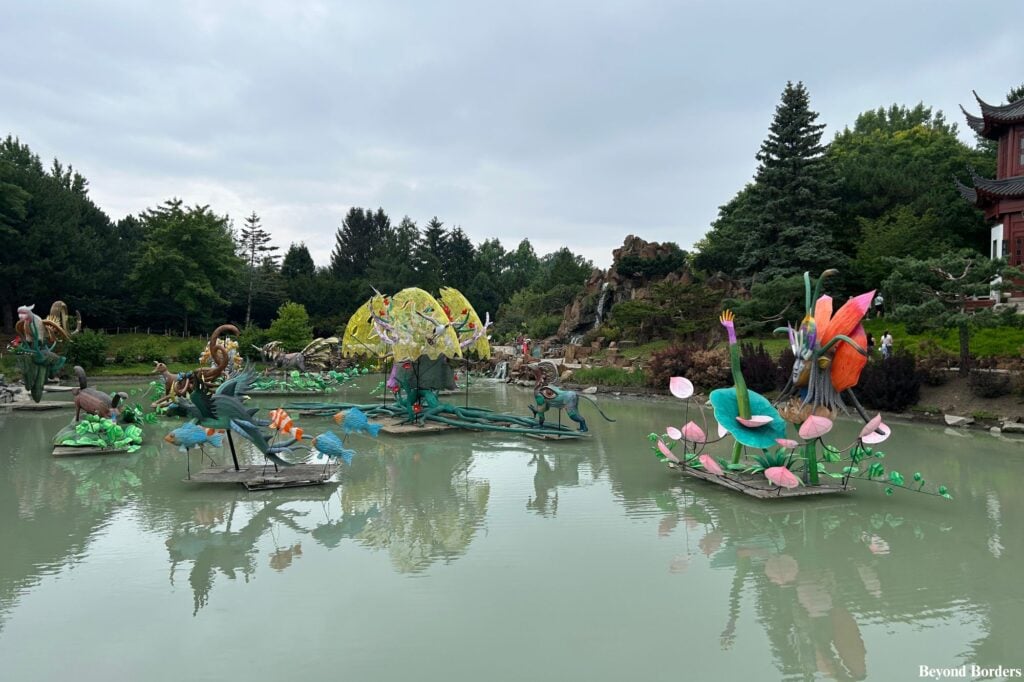
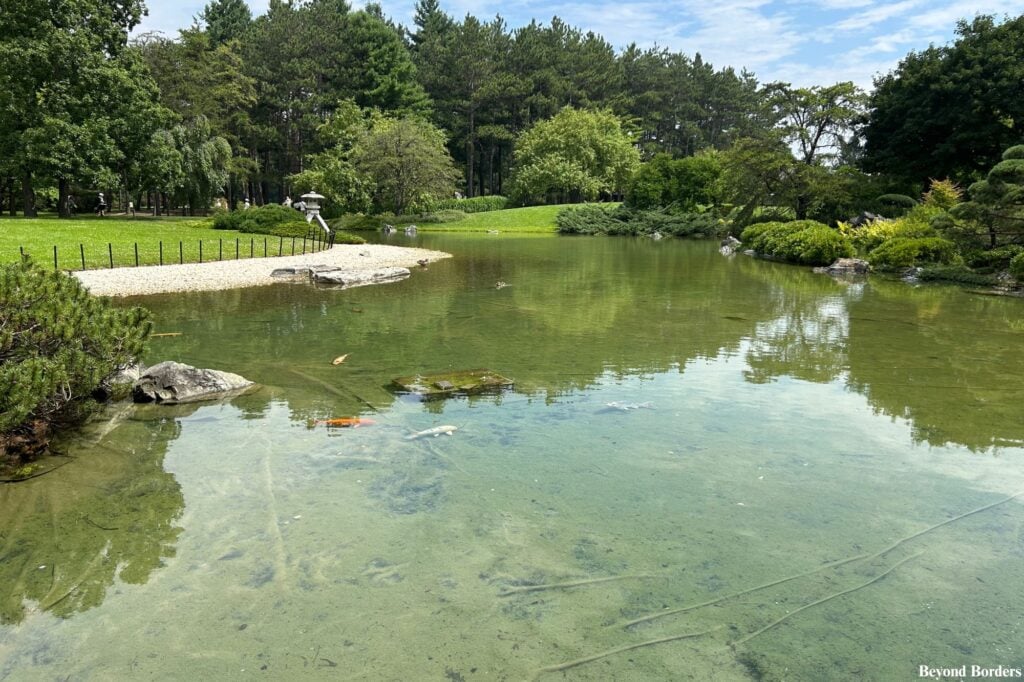

Montreal Biodome
How to get here: Walk 15 minutes from the Botanical Garden, or walk back to Pie-IX station and take the metro one stop to the Viau station on the green line. After leaving the train, you will see a sign pointing in the direction of the Biodome.
The Montreal Biodome is a museum that allows visitors to walk through replicas of different ecosystems found in the Americas. It’s a popular attraction, especially for families. The Biodome recreates several ecosystems under one roof, complete with their native animals and plants. Visitors follow a winding path that takes them through each environment.
The five ecosystems of the Americas that the Biodome features are:
The Tropical Rainforest: This is the largest ecosystem featured. It’s a warm, humid environment with a vibrant array of plants, birds (including macaws), reptiles (like caimans and anacondas), and mammals such as sloths and monkeys.
The Laurentian Maple Forest: This exhibit changes with the seasons, just like a real Quebec forest. You can see animals like beavers, porcupines, and river otters.
The Gulf of St. Lawrence: This is an aquatic ecosystem modeled after the largest estuary in the world. It features a massive tank filled with “seawater” and is home to a variety of fish, including several species of sharks and rays. Birds that frequent the coastline can also be found here.
The Labrador Coast: This section is dedicated to the seabirds, including Atlantic puffins. You can watch them “fly” underwater and waddle on the rocky terrain.
The Sub-Antarctic Islands: This chilly habitat is one of the most popular parts of the Biodome! It’s home to a colony of penguins, including King penguins and Northern rockhopper penguins. You can watch them swim at high speed through a large window or waddle on land.
The Biodome also includes a mezzanine level to give visitors unique vantage points over the ecosystems. The appeal of the Biodome is less about seeing a huge variety of animals and more about experiencing these five distinct North and South American ecosystems in a single visit. The Biodome might be more appealing to those who appreciate a walk-through, immersive environment rather than a collection of animal exhibits, like at a large zoo. However, for families with young children or those who want to experience a quick “trip” through a rainforest, a maple forest, and a penguin colony all under one roof, it can be a unique experience. You can purchase tickets online at the official website here.

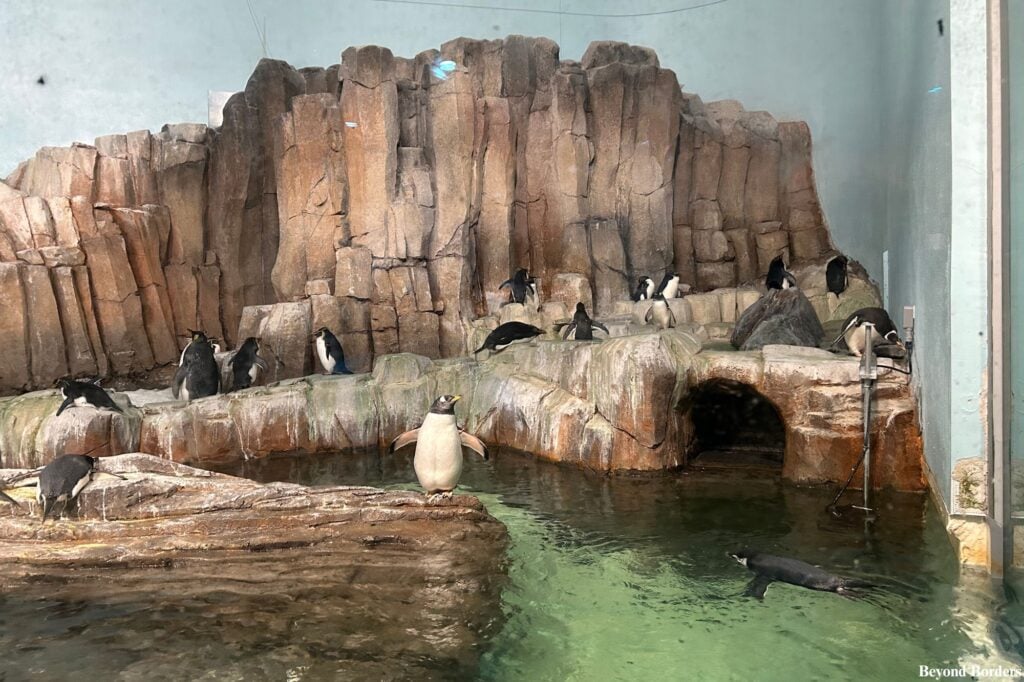
Lunch
After leaving the Biodome, grab a quick bite to eat nearby before heading south back to Ville-Marie. An inexpensive option is Canard Café, a coffee shop and bakery. Another option is Restaurant La Belle Province, a fast-food restaurant offering Québécois cuisine, including poutines, hot dogs & smoked meat sandwiches.
Hike up Mount Royal to the Kondiaronk Belvedere viewpoint
How to get here: Take the metro from the Viau or Pie-IX station to the Peel station on the green line. When leaving the station, look for a sign that says “Rue Metcalfe” and exit the station. Walk on Rue Metcalfe, and then make a left onto Rue Sherbrooke Ouest, and then make a right onto Rue Peel.
As you walk up Rue Peel, you will walk uphill and see many McGill University buildings! Take your time walking up Rue Peel; it does not look steep, but it can tire you out quickly. At the end of Rue Peel, you will reach Avenue des Pins and will see the Rue Peel Steps right across the street!
The Rue Peel Steps turn into the Grand Staircase of Mount Royal as you walk into and through Mount Royal Park. There are a total of 339 steps going up towards the Kondiaronk Belvedere viewpoint, allowing you to see unparalleled views of the Montreal skyline! You will see walking/biking paths as you continue to walk up the Grand Staircase. Don’t walk on the paths; continue walking towards and then up the stairs.
Feel free to take breaks as you walk up the stairs; after your trek up, you will be rewarded with stunning views! When you reach the viewpoint, you will see the Mount Royal Chalet, a 1932 cottage that now has a gift shop, a small café, and restrooms.
After spending time taking in the views and relaxing, walk back down the staircase and down Rue Peel to the Peel metro station to go to Chinatown for dinner.
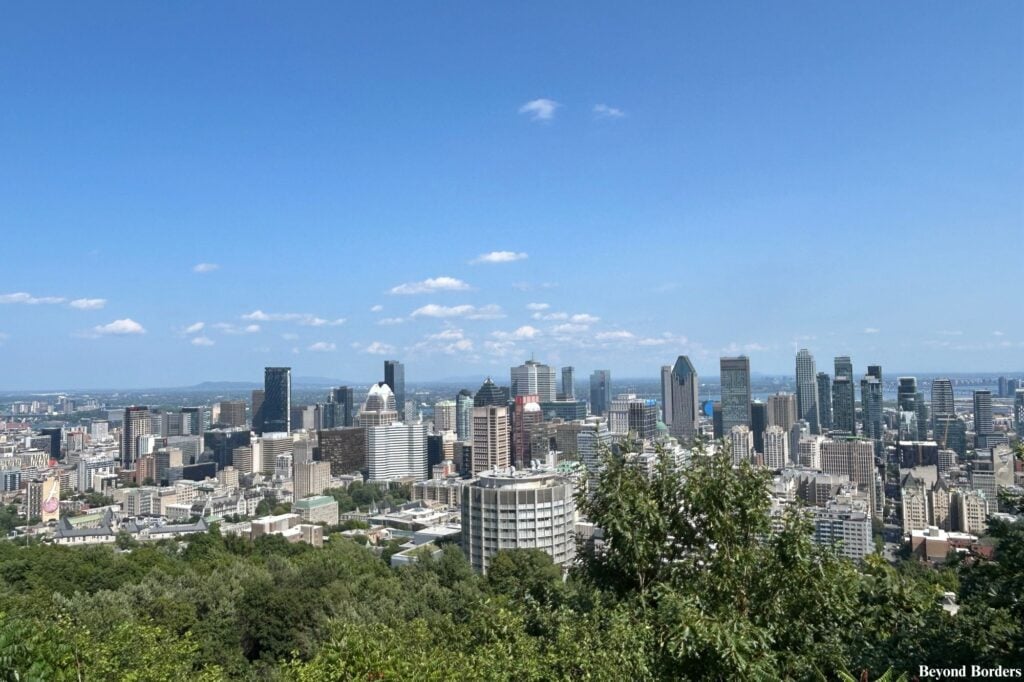
Dinner in Chinatown
How to get here: Take the metro from Peel station to the Saint Laurent station on the green line, and walk onto Saint Laurent Boulevard from the station. Then, make a right onto Boulevard René-Lévesque Ouest and a left onto Rue Clark.
Montreal’s Chinatown is small compared to others, like New York City’s (which I include in my New York Itineraries), but it still has plenty of restaurants and shops to enjoy! I recommend getting food at Qing Hua, a restaurant that specializes in dumplings. Other popular restaurants include Nouilles de Lan Zhou, a restaurant specializing in noodles, and Chez Chili, a restaurant with a diverse Chinese menu. After dinner, I recommend walking to Pâtisserie Coco, a Chinese bakery, for dessert.

Day 3
St-Viateur Bagel and Café
How to get here: Take the metro to Mont-Royal station on the orange line. After walking out of the station, make a right onto Mont-Royal Ave and you will see St-Viateur on your left.
St-Viateur Bagel and Café is one of Montreal’s two famous bagel shops, the other being Fairmount Bagel, further west. St-Viateur opened in 1957 and has become a central part of the city’s culinary identity, attracting both locals and tourists. St-Viateur is cash only, so make sure you have CAD with you! You might see a line when you get there, but the line moves fast.
What makes St-Viateur so famous is how they make their hand-rolled bagels. The dough is hand-rolled, boiled in honey-sweetened water, and then baked in a wood-fired oven. This method results in a bagel that is sweeter, denser, and has a crisper, smokier crust compared to New York-style bagels. St-Viateur has even been included in Anthony Bourdain’s No Reservations, a highly popular American travel and food television show that aired from 2005 to 2012.
La Fontaine Park
How to get here: Walk less than 10 minutes to La Fontaine Park from St-Viateur Bagel and Café. Make a right onto Rue de la Roche and then make a left onto Rue Rachel East.
La Fontaine Park (Parc La Fontaine in French) is one of Montreal’s most beautiful urban parks. At 84 acres, it is easily accessible and serves as a major public space for the surrounding neighborhoods. The park has a large artificial pond with a fountain and the Théâtre de Verdure, an open-air amphitheater, in front of the pond that hosts free concerts and performances during the summer.
The park has several walking and biking paths, benches, several tennis courts, a baseball field, and a small ice hockey rink. There is also a monument dedicated to French poet Jean de La Fontaine, for whom the park is named. Spend some time relaxing in the park, walking along the tree-lined paths, and sitting on a bench before heading to Little Italy!
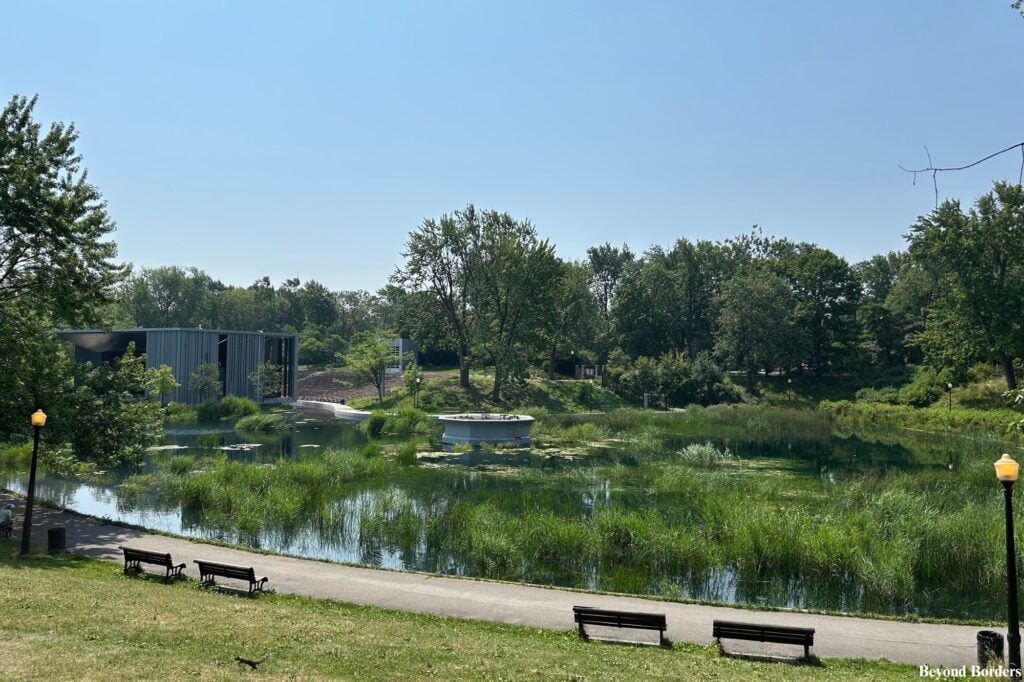
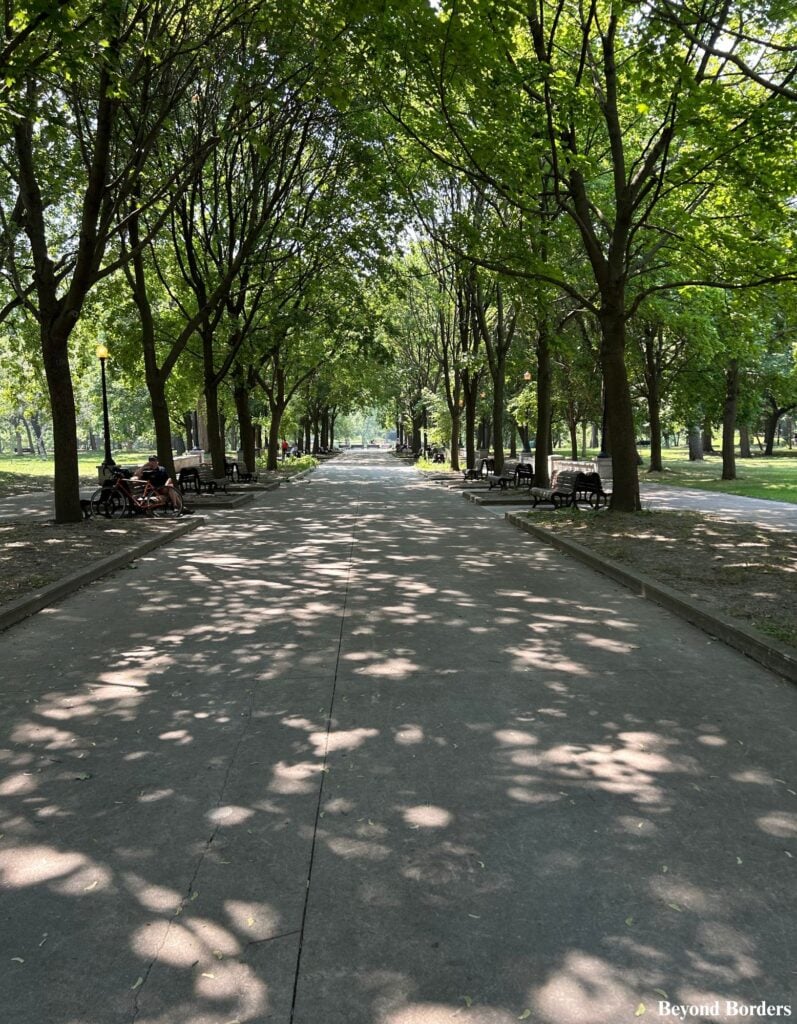
Jean Talon Market and lunch in Little Italy
How to get here: Walk back to Mont-Royal station and take the metro to Jean Talon station on the orange line. When exiting the station, walk onto Rue Jean-Talon East and then make a left onto Avenue Henri-Julien. You will see the market on your right!
Jean-Talon Market, located in Montreal’s Little Italy, is one of the oldest and largest open-air markets in North America. Since its opening in 1933, it has been a bustling hub for food lovers! The market has a large variety of stalls and specialty shops. It is also open year-round; the central section is enclosed with walls to protect vendors and shoppers from the cold, and you will still be able to find a great selection of local and imported goods.
The market is most famous for its incredible selection of fruits, vegetables, and flowers, especially during peak months (May to October) when over 300 vendors, mostly farmers from the Montreal countryside, set up their stalls! You will see lots of signs telling you what produce is grown in Quebec as well. Speciality shops include butchers, fishmongers, bakeries, and cheese shops.
The market is also a great place to grab a quick bite for lunch. You can find stands selling everything from fresh crepes and artisanal sausages to international street food!
If you want to get lunch elsewhere in Little Italy, Italian restaurants nearby include Café San Gennaro, a pizza restaurant, Il Bazzali, a restaurant that offers handmade pasta, and Panino Pazzo, a sandwich shop.

St. Joseph’s Oratory
How to get here: Take the metro from Jean Talon station to Côte-des-Neiges station on the blue line. As you leave the station, you will see a sign pointing in the direction of St. Joseph’s Oratory. Follow the sign and make a right onto Chem. de la Côte-des-Neiges. Then, make a right onto Chem. Queen Mary, and you will see St. Joseph’s Oratory on your left!
St. Joseph’s Oratory is one of Montreal’s most recognizable landmarks. It is a Roman Catholic minor basilica, a National Historic Site of Canada, and the largest church in Canada. It attracts more than 2 million visitors and pilgrims each year.
Its monumental scale and distinctive dome make it a dominant feature of the Montreal skyline, rising higher than the summit of Mount Royal itself! The Oratory’s dome is the largest church dome in Canada and the third-largest in the world. The dome’s design was actually inspired by the Florence Cathedral (Cattedrale di Santa Maria del Fiore).
The walk up to the Oratory from street level consists of 283 steps. Feel free to admire the basilica and take photos from street level or walk up the steps if you have the energy!

What about the Espace pour la vie Passport?
You will see when you go online to buy tickets for the Montreal Botanical Garden and the Biodome that there is a link to purchase the “Espace pour la vie Passport.” This annual pass gives you unlimited access to all five of Montreal’s “Space for Life” museums: the Biodome, the Biosphere, the Insectarium, the Botanical Garden, and the Planetarium.
Here are the current regular rates for the Espace pour la vie Passport in CAD: Solo Passport, $87; Solo +1 Passport: $119.50 (for one adult and one child); Multi Passport: $149 (for a couple or a family with a maximum of 2 adults and 3 children); Additional Child: $32.50.
The passport is a good option if you plan on visiting multiple attractions or making several visits throughout the year, as it can offer significant savings compared to buying individual tickets each time. It’s valid for 12 months from the date of purchase.
However, for this itinerary, it is not worth it to get the Espace pour la vie Passport, since you will only be visiting the Botanical Garden and the Biodome, and because you (likely) won’t be making multiple visits throughout the year.
Alternative Attractions
If you have extra time, want to try something else, or if any attractions are too crowded for your liking or are unexpectedly closed, here are some other things to do:
Marché Atwater
Marché Atwater is a popular public market located in the Saint-Henri neighborhood of Montreal. It’s a year-round destination known for its beautiful Art Deco architecture, diverse food, and vibrant atmosphere. It consists of a year-round indoor market, a seasonal outdoor market, restaurants, and food vendors.
The indoor market is home to many permanent vendors, including butchers, a bakery (Première Moisson), cheese shops, and a fishmonger. You can find fresh meat, fish, baked goods, and a wide selection of cheeses from Quebec.
Between spring and winter, the outdoor market is home to stalls selling a vast array of fresh produce, flowers, and herbs from local farmers. In winter, the outdoor area is enclosed with insulated walls, and the market becomes a cozy space, often hosting a Christmas Village with festive treats and activities. The entire market is a hub for gourmet and specialty products.
Both the Lionel-Groulx and Charlevoix metro stations are close to the market, making it easily accessible by metro.
Montreal Science Centre
The Montreal Science Centre is a science museum located in the Old Port of Montreal and is a popular destination for families and anyone interested in exploring the world of science and technology. It features seven activity areas where visitors can learn about motion, air, light, water, geometry, matter, and even coding through life-sized experiments.
The Place d’Armes metro station is the closest station to the museum. To learn more and to purchase tickets, check out the website here.
La Grande Roue de Montréal
La Grande Roue de Montréal is also called the Montreal Observation Wheel and is a prominent landmark in the Old Port of Montreal. It was built for the city’s 375th-anniversary celebrations in 2017. It is the tallest Ferris wheel in Canada at 200 feet (60 meters) tall. La Grande Roue typically lasts about 20 minutes, giving you plenty of time to take in the scenery and get 360-degree views of the city skyline and the St. Lawrence River. The wheel is also designed to operate 365 days a year, with climate-controlled cabins that are air-conditioned in the summer and heated in the winter. To buy tickets, check out the official website here.
Where should you stay?
Luxury: Le Mount Stephen; Ritz-Carlton Montréal
Le Mount Stephen is located within walking distance to Peel metro station and the MMFA. Guests loved the spacious rooms, electronic room controls, and helpful staff. The Ritz-Carlton embodies elegance, and its Montreal location is no exception. The hotel is close to Le Mount Stephen, and guests loved the impeccable service, spacious rooms, and amenities.
Mid-range: Hôtel Alt Montréal; Hôtel Château de l’Argoat
Hôtel Alt Montréal is located in Old Montreal. Guests appreciated the easy check-in/out, the clean rooms, and the proximity to restaurants. The Hôtel Château de l’Argoat is located within walking distance to La Fontaine Park and the Sherbrooke metro station. Guests liked the clean and spacious rooms and proximity to both the metro station and Old Montreal.
Budget: M Montréal; Maison Des Jardins
M Montréal is more of a hostel than a hotel, but you can book private rooms. If you want to learn more about hostels, read this article. It is also within walking distance to the Beaudry metro station. Guests liked the clean rooms, nice amenities, and location. Maison Des Jardins is a bed and breakfast on a quieter street but still within walking distance to the Beaudry metro station. Guests loved the breakfast, clean rooms, and location.
Food Recommendations
- Kem CoBa ice cream: cash only, CAD and USD accepted
- Iconoglace ice cream: handmade waffle cones every day
- Cafe St Barth’s: serves breakfast and brunch
- Crêperie Maison Bagatelle: close to Notre Dame Basilica
- Fairmount Bagel: cash only, CAD and USD accepted
- St Viateur bagel: cash only
- Café Olímpico—Mile End
- Qing Hua: dumplings in Chinatown
- Kyo Bar Japonais
- Tommy Café
- Schwartz’s Deli: take cash and credit/debit
- Le Central food hall
- Timeout Market food hall
- La Banquise: A popular 24/7 diner close to La Fontaine Park

